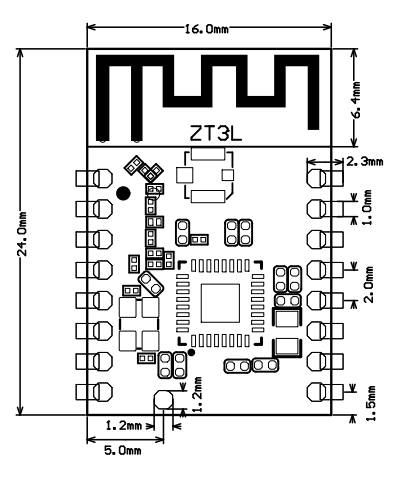
ZT3L is a low-power embedded Zigbee module that Tuya has developed. It consists of a highly integrated RF processing chip (TLSR8258F1KAT32), a few peripherals, a built-in 802.15.4 PHY/MAC Zigbee network protocol stack, and rich library functions. ZT3L is embedded with a low-power 32-bit CPU, 1-MB flash program memory, a 64-KB RAM, and abundant peripheral resources.
ZT3L is a FreeRTOS platform that integrates all function libraries of the Zigbee MAC and TCP/IP protocols. You can develop embedded Zigbee products as required.
| Date | Updated content | Version after update |
|---|---|---|
| 11/24/2020 | This is the first release. | V1.0.0 |
ZT3L has two rows of pins with a 2±0.1 mm pin spacing.
The ZT3L dimensions are 24±0.35 mm (L)×16±0.35 mm (W) ×2.8±0.15 mm (H).
The dimensions of ZT3L are as follows:

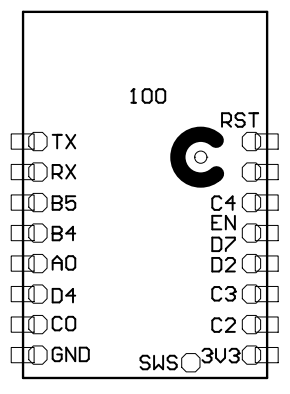
| Pin number | Symbol | I/O type | Function |
|---|---|---|---|
| 1 | RST | I | Hardware reset pin; by default, high level; active low |
| 2 | C4 | I/O | ADC pin, which corresponds to C4 (Pin 24) on the internal IC |
| 3 | EN | I | The enabling pin and the RST pin are connected together and a pull-up resistor is connected to them inside the module. |
| 4 | D7 | I/O | Common I/O pin, which corresponds to D7 (Pin 2) on the internal IC |
| 5 | D2 | I/O | Support hardware PWM and correspond to D2 (Pin 31) on the internal IC |
| 6 | C3 | I/O | Support hardware PWM and correspond to C3 (Pin 23) on the internal IC |
| 7 | C2 | I/O | Support hardware PWM and correspond to C2 (Pin 22) on the internal IC |
| 8 | 3V3 | P | Power supply pin of the module (The typical power supply voltage: 3.3V |
| 9 | GND | P | Power supply reference ground |
| 10 | C0 | I/O | Common I/O pin, which corresponds to C0 (Pin 20) on the internal IC |
| 11 | D4 | I/O | Common I/O pin, which corresponds to D4 (Pin 1) on the internal IC |
| 12 | A0 | I/O | Common I/O pin, which corresponds to A0 (Pin 3) on the internal IC |
| 13 | B4 | I/O | Support hardware PWM and correspond to B4 (Pin 14) on the internal IC |
| 14 | B5 | I/O | Support hardware PWM and correspond to B5 (Pin 15) on the internal IC |
| 15 | RXD | I/O | Uart_RXD, which corresponds to B7 (Pin 17) on the internal IC |
| 16 | TXD | I/O | Uart_TXD, which corresponds to B1 (Pin 6) of the IC |
| 17 | SWS | I/O | Burning pin, which corresponds to SWS (Pin 5) on the internal IC |
Note: P indicates a power supply pin and I/O indicates an input/output pin.
| Parameter | Description | Minimum value | Maximum value | Unit |
|---|---|---|---|---|
| Ta | Working temperature | -40 | 125 | ℃ |
| VBAT | Power supply voltage | 1.8 | 3.6 | V |
| Static electricity discharge voltage (human body model) | TAMB-25℃ | - | 2 | KV |
| Static electricity discharge voltage (machine model) | TAMB-25℃ | - | 0.5 | KV |
| Parameter | Description | Minimum Value | Typical Value | Maximum Value | Unit |
|---|---|---|---|---|---|
| Ta | Working temperature | -40 | - | 125 | ℃ |
| VCC | Working voltage | 1.8 | 3.3 | 3.6 | V |
| VIL | I/O low level input | - | - | VDD*0.3 | V |
| VIH | I/O high level input | VDD*0.7 | - | - | V |
| VOL | I/O low level output | - | - | VDD*0.2 | V |
| VOH | I/O high level output | VDD*0.8 | - | - | V |
| Working status | Mode | Rate | Transmit power/receive | Average value | Peak value (Typical value)) | Unit |
|---|---|---|---|---|---|---|
| Transmit | - | 250 Kbps | +10 dBm | 18 | 38 | mA |
| Transmit | - | 250 Kbps | +0 dBm | 6 | 34 | mA |
| Receive | - | 250 Kbps | Constantly receive | 5.3 | 38 | mA |
| Working mode | Working status, Ta = 25°C | Average value | Maximum value (Typical value) | Unit |
|---|---|---|---|---|
| Quick connection network state | The module is in the fast network connection state | 3 | 34 | mA |
| Network connection state | The module is connected to the network | 6 | 38 | mA |
| Deep sleep mode | Deep sleep mode, reserve 32-KB SRAM | 1.4 | - | uA |
| Parameter | Description |
|---|---|
| Working frequency | 2.405 to 2.480 GHz |
| Zigbee standard | IEEE 802.15.4 |
| Data transmission rate | 250 Kbps |
| Antenna type | PCB antenna with a gain of 3.09 dBi, ipex optional |
TX performance
| Parameter | Minimum value | Typical value | Maximum value | Unit |
|---|---|---|---|---|
| Maximum output power (250Kbps) | - | 10 | - | dBm |
| Minimum output power (250Kbps) | - | -25 | - | dBm |
| Output power adjustment stepping | - | 0.5 | 1 | dBm |
| Output spectrum adjacent channel suppression | - | -31 | - | dBc |
| Frequency error | -15 | - | 15 | ppm |
RX sensitivity
| Parameter | Minimum value | Typical value | Maximum value | Unit |
|---|---|---|---|---|
| PER<8%, RX sensitivity (250 Kbps) | -102 | -101 | -99 | dBm |
ZT3L only uses the onboard PCB antenna.
To ensure the optimal Wi-Fi performance when the Zigbee module uses an onboard PCB antenna, it is recommended that the antenna be at least 15 mm away from other metal parts.
To prevent an adverse impact on the antenna radiation performance, avoid copper or traces along the antenna area on the PCB.

The PCB dimensions are 24±0.35 mm (L)×16±0.35 mm (W) ×2.8±0.15 mm (H).


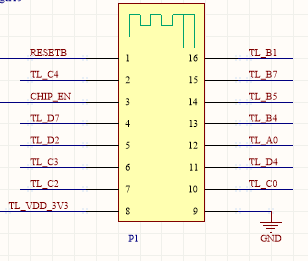
ZT3L can choose SMT placement or pin header plug-in. The dimensions of the plug-in are as follows:
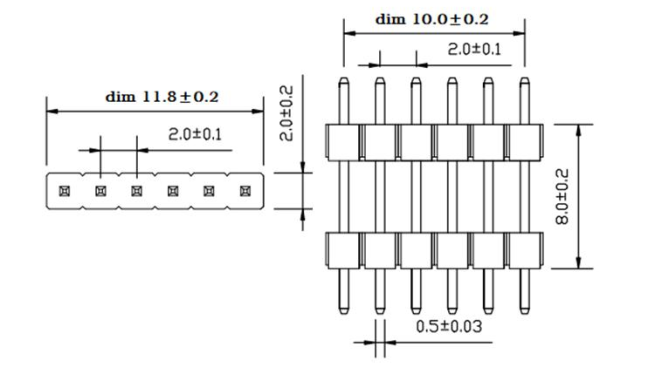
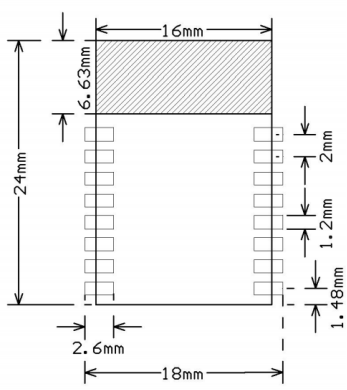
Mount Tuya’s stamp hole package module with an SMT machine within 24 hours after unpacking and burning the firmware. Otherwise, the module must be packaged again under vacuum. The module must be baked before mounting.
Storage conditions for a delivered module are as follows:

Bake a module based on HIC status as follows when you unpack the module package:
Baking settings:
Do not use SMT to process modules that have been unpacked for more than 3 months, because electroless nickel/immersion gold (ENIG) is used for PCBs and they are seriously oxidized for over 3 months. SMT is very likely to cause pseudo and missing soldering. Tuya is not liable for such problems and consequences.
Before using SMT, take electrostatic discharge (ESD) protective measures.
To reduce the reflow defect rate, draw 10% of the products for visual inspection and AOI before the first mounting, to determine the rationality of oven temperature control and component attachment and placement manners. Draw 5 to 10 modules from subsequent batches each hour for visual inspection and AOI.
Perform SMT based on the following reflow oven temperature curve. The highest temperature is 245°C. The reflow temperature curve is as below:
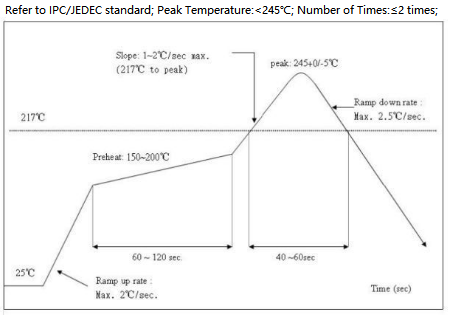
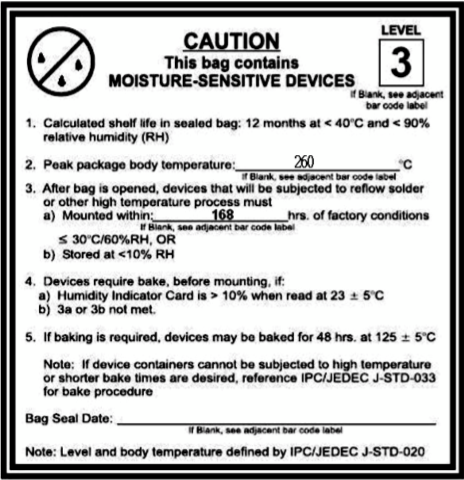
| Product number | MOQ (pcs) | Shipping packaging method | The number of modules per reel | The number of reels per carton |
|---|---|---|---|---|
| ZT3L | 4000 | Tape reel | 1000 | 4 |
FCC Caution: Any changes or modifications not expressly approved by the party responsible for compliance could void the user’s authority to operate this device.
This device complies with Part 15 of the FCC Rules. Operation is subject to the following two conditions: (1) This device may not cause harmful interference, and (2) this device must accept any interference received, including interference that may cause undesired operation.
Note: This device has been tested and found to comply with the limits for a Class B digital device, according to part 15 of the FCC Rules. These limits are designed to provide reasonable protection against harmful interference in a residential installation. This device generates, uses, and can radiate radio frequency energy and, if not installed and used following the instructions, may cause harmful interference to radio communications. However, there is no guarantee that interference will not occur in a particular installation.
If this device does cause harmful interference to radio or television reception, which can be determined by turning the device off and on, the user is encouraged to try to correct the interference by one or more of the following measures:
Radiation Exposure Statement
This device complies with FCC radiation exposure limits set forth for an uncontrolled rolled environment. This device should be installed and operated with a minimum distance of 20cm between the radiator and your body.
Important Note
This radio module must not be installed to co-locate and operating simultaneously with other radios in the host system except following FCC multi-transmitter product procedures. Additional testing and device authorization may be required to operate simultaneously with other radios.
The availability of some specific channels and/or operational frequency bands are country dependent and are firmware programmed at the factory to match the intended destination. The firmware setting is not accessible by the end-user.
The host product manufacturer is responsible for compliance with any other FCC rules that apply to the host not covered by the modular transmitter grant of certification. The final host product still requires Part 15 Subpart B compliance testing with the modular transmitter installed.
The end-user manual shall include all required regulatory information/warnings as shown in this manual, including “This product must be installed and operated with a minimum distance of 20 cm between the radiator and user body”.
This device has got an FCC ID: 2ANDL-ZT3L. The end product must be labeled in a visible area with the following: “Contains Transmitter Module FCC ID: 2ANDL-ZT3L”.
This device is intended only for OEM integrators under the following conditions:
The antenna must be installed such that 20cm is maintained between the antenna and users, and 2) The transmitter module may not be co-located with any other transmitter or antenna.
As long as the 2 conditions above are met, further transmitter tests will not be required. However, the OEM integrator is still responsible for testing their end-product for any additional compliance requirements required with this module installed.
Declaration of Conformity European Notice

Hereby, Hangzhou Tuya Information Technology Co., Ltd declares that this module product is in compliance with essential requirements and other relevant provisions of Directive 2014/53/EU,2011/65/EU. A copy of the Declaration of conformity can be found at https://www.tuya.com.

This product must not be disposed of as normal household waste, in accordance with the EU directive for waste electrical and electronic equipment (WEEE-2012/19/EU). Instead, it should be disposed of by returning it to the point of sale, or to a municipal recycling collection point.
The device could be used with a separation distance of 20cm to the human body.